By Jennifer Dorsett
Field Editor
Beef cattle inventory expansion appears to be slowing as drought spreads across the majority of cattle country.
Moderate drought conditions began last fall and intensified over the winter. Weather experts forecast dry conditions will trend through June.
As of Jan. 1, the U.S. Department of Agriculture (USDA) reported an inventory of 31.7 million beef cows, the largest number since 2008. But breeding inventory is decreasing, signaling an overall decrease in the rate of cowherd expansion.
Twenty-seven percent of the nation’s total—8.59 million cows—is located in Texas and the surrounding four states. Of those, only Arkansas is not experiencing drought at this time. New Mexico is facing some drought conditions, as well as most of Texas and a large part of Oklahoma. Even Louisiana is abnormally dry along portions of the Gulf Coast.
“This situation has many ranchers thinking back 10 years ago when Texas went through a prolonged and devastating drought,” Tracy Tomascik, associate director of Commodity and Regulatory Activities, said. “People had to change their normal operations, sell calves sooner and cull cows before they would have liked to.”
So far, drought conditions have forced ranchers to send cattle to feedyards earlier than planned, pushing cattle on feed to nearly 14 million head as of Jan. 1.
The rise in feedlot inventory will cause an uptick in beef production as feedlots try to keep up with the increased numbers. Beef production is expected to be up six percent compared to last year, according to beef marketing experts.
Another factor expected to increase this year is beef production per cow, up four percent over 2017.
As production and supply increases, prices may drop. This could trigger a continued downward influence on replacement animals in the future and cause a decrease in the U.S. cattle herd expansion.

